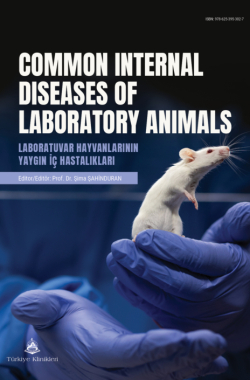Hantavirus Infection in Laboratory Animals
Metin Koray ALBAYa , Caner SEVERb
aBurdur Mehmet Akif Ersoy University Faculty of Veterinary Medicine, Department of Internal Medicine, Burdur, Türkiye
bBurdur Mehmet Akif Ersoy University Institute of Health Sciences, Department of Internal Medicine, Burdur, Türkiye
Albay MK, Sever C. Hantavirus infection in laboratory animals. In: Şahinduran Ş, ed. Common Internal Diseases of Laboratory Animals. 1st ed. Ankara: Türkiye Klinikleri; 2024. p.27-31.
ABSTRACT
Hantavirus is a zoonotic virus with high infectivity among humans. Although Hantavirus was identified 50 years ago, there is evidence dating back 900 years. Hantaviruses, which are in the Bunyaviridae family, have caused two different epidemics in the last century. Small mammals, especially different rodent species, are reservoirs of hantavirus infections. The most common hosts are rodents. Although the viruses do not cause disease in rodents, these viruses are transmitted to humans through rodent feces or excretions. The virus can be divided into old and new world viruses. This difference is also reflected in the infections caused by the virus in humans. Although the virus is found in almost all continents, it has been reported most in the Far Eastern countries and eastern Russia. Hantavirus infections are persistent in rodents and insectivores. It is usually asymptomatic. There are no antiviral drugs available to completely cure Hantavirus infection in humans. Additionally, vaccines are not effective enough. This chapter aimed to reveal the potential zoonotic risks of hantaviruses in laboratory animals and to emphasize their importance.
Keywords: Hantavirus; rodent; zoonoses
Kaynak Göster
Referanslar
- Jiang DB, Zhang JP, Cheng LF, Zhang GW, Li Y, Li ZC, et al. Hantavirus Gc induces long-term immune protection via LAMP-targeting DNA vaccine strategy. Antiviral Research. 2018;150:174-82. [Crossref] [PubMed]
- Brocato RL, Hooper JW. Progress on the Prevention and Treatment of Hantavirus Disease. Viruses. 2019;11(7):610. [Crossref] [PubMed] [PMC]
- Kostakoglu U, Yılmaz G, Volkan S, Kant Sokel S, Kaya S, Koksal I. Evaluation of clinical and laboratory predictors of fatality in patients with Hantavirus infection. J Microbil Infect Dis. 2012;2(04):155-9. [Crossref]
- Avšič-Županc T, Saksida A, Korva M. Hantavirus infections. Clin Microbiol Infect. 2019;21S:e6-e16. [Crossref] [PubMed]
- Altun DU, Oktem IMA, Unal B. Hantavirus Infections and Prevention of Hantaviruses. TAF Prev Med Bull. 2011;10(3):373-8. [Crossref]
- Singh S, Numan A, Sharma D, Shukla R, Alexander A, Jain GK, et al. Epidemiology, virology and clinical aspects of hantavirus infections: an overview. Int J Environ Health Res. 2022;32(8):1815-26. [Crossref] [PubMed]
- Bi Z, Formenty PB, Roth CE. Hantavirus infection: a review and global update. J Infect Dev Ctries. 2008;2(1):3-23. [Crossref] [PubMed]
- Schmaljohn CS, Hasty SE, Dalrymple JM, LeDuc JW, Lee HW, von Bonsdorff CH, et al. Antigenic and genetic properties of viruses linked to hemorrhagic fever with renal syndrome. Science. 1985 Mar 1;227(4690):1041-4. [Crossref] [PubMed]
- Fallon MT. Hantavirus infection. In: Laber-Laird K, Swindle MM, Flecknell PA, eds. Handbook of Rodent and Rabbit Medicine (Pergamon Veterinary Handbook). 1st ed. Chicago Uni: Elsevier Science & Technology Books; 1996. p. 25-6.
- Clement J, LeDuc JW, Lloyd G, Reynes JM, McElhinney L, Van Ranst M, et al. Wild Rats, Laboratory Rats, Pet Rats: Global Seoul Hantavirus Disease Revisited. Viruses. 2019;11(7):652. [Crossref] [PubMed] [PMC]
- Laenen L, Vergote V, Calisher CH, Klempa B, Klingström J, Kuhn JH, et al. Hantaviridae: Current Classification and Future Perspectives. Viruses. 2019 Aug 27;11(9):788. [Crossref] [PubMed] [PMC]
- Vaheri A, Vapalahti O, Plyusnin A. How to diagnose hantavirus infections and detect them in rodents and insectivores. Rev Med Virol. 2008;18(4):277-88. [Crossref] [PubMed]
- Vaheri A, Strandin T, Hepojoki J, Sironen T, Henttonen H, Mäkelä S, et al. Uncovering the mysteries of hantavirus infections. Nat Rev Microbiol. 2013;11(8):539-50. [Crossref] [PubMed]
- Romero MG, Rout P, Anjum F. Hemorrhagic Fever Renal Syndrome. [Updated 2023 Nov 5]. In: StatPearls [Internet]. Treasure Island (FL): StatPearls Publishing; 2024 Jan-.
- Arai S, Taniguchi S, Aoki K, Yoshikawa Y, Kyuwa S, Tanaka-Taya K, et al. Molecular phylogeny of a genetically divergent hantavirus harbored by the Geoffroy's rousette (Rousettus amplexicaudatus), a frugivorous bat species in the Philippines. Infect Genet Evol. 2016;45:26-32. [Crossref] [PubMed]
- Bennett SN, Gu SH, Kang HJ, Arai S, Yanagihara R. Reconstructing the evolutionary origins and phylogeography of hantaviruses. Trends Microbiol. 2014; 22(8):473-82. [Crossref] [PubMed] [PMC]
- Muranyi W, Bahr U, Zeier M, van der Woude FJ. Hantavirus infection. J Am Soc Nephrol. 2005;16(12):3669-79. [Crossref] [PubMed]
- Klempa B. Hantaviruses and climate change. Clin Microbiol Infect. 2009;15(6):518-23. [Crossref] [PubMed]
- Schmaljohn C, Hjelle B. Hantaviruses: a global disease problem. Emerg Infect Dis. 1997;3(2):95-104. [Crossref] [PubMed] [PMC]
- Macneil A, Nichol ST, Spiropoulou CF. Hantavirus pulmonary syndrome. Virus Res. 2011;162(1-2):138-47. [Crossref] [PubMed]
- Suckow MA, Hashway S, Pritchett-Corning KR. The Laboratory Mouse. 3rd ed. Florida: CRC Press; 2023. p. 108. [Crossref]
- Sanada T, Kariwa H, Saasa N, Yoshikawa K, Seto T, Morozov VG, et al. Development of a diagnostic method applicable to various serotypes of hantavirus infection in rodents. J Vet Med Sci. 2012;74(9):1237-42. [Crossref] [PubMed]

